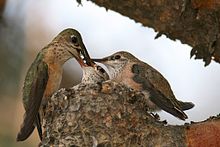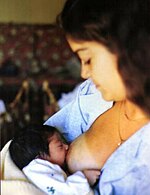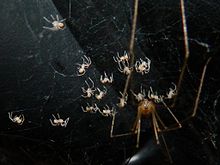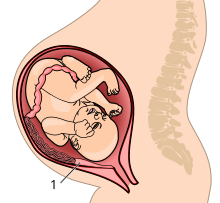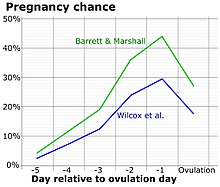From Wikipedia, the free encyclopedia
A human mother feeding her child
Parental investment, in
evolutionary biology and
evolutionary psychology, is any parental expenditure (e.g. time, energy, resources) that benefits
offspring.
Parental investment may be performed by both males and females
(biparental care), females alone (exclusive maternal care) or males
alone (exclusive
paternal care).
Care can be provided at any stage of the offspring's life, from
pre-natal (e.g. egg guarding and incubation in birds, and placental
nourishment in mammals) to post-natal (e.g. food provisioning and
protection of offspring).
Parental investment theory, a term coined by
Robert Trivers
in 1972, predicts that the sex that invests more in its offspring will
be more selective when choosing a mate, and the less-investing sex will
have intra-sexual competition for access to mates. This theory has been
influential in explaining sex differences in
sexual selection and
mate preferences, throughout the animal kingdom and in humans.
History
In 1859,
Charles Darwin published
On the Origin of Species. This introduced the concept of
natural selection to the world, as well as related theories such as
sexual selection.
For the first time, evolutionary theory was used to explain why females
are "coy" and males are "ardent" and compete with each other for
females' attention. In 1930,
Ronald Fisher wrote
The Genetical Theory of Natural Selection, in which he introduced the modern concept of parental investment, introduced the
sexy son hypothesis, and introduced
Fisher's principle. In 1948,
Angus John Bateman
published an influential study of fruit flies in which he concluded
that because female gametes are more costly to produce than male
gametes, the reproductive success of females was limited by the ability
to produce ovum, and the reproductive success of males was limited by
access to females. In 1972,
Trivers
continued this line of thinking with his proposal of parental
investment theory, which describes how parental investment affects
sexual behavior. He concludes that the sex that has higher parental
investment will be more selective when choosing a mate, and the sex with
lower investment will compete intra-sexually for mating opportunities.
In 1974, Trivers extended parental investment theory to explain
parent-offspring conflict, the conflict between investment that is
optimal from the parent's versus the offspring's perspective.
Parental care
Parental investment theory is a branch of
life history theory. The earliest consideration of parental investment is given by
Ronald Fisher in his 1930 book
The Genetical Theory of Natural Selection,
wherein Fisher argued that parental expenditure on both sexes of
offspring should be equal. Clutton-Brock expanded the concept of
parental investment to include costs to any other component of parental
fitness.
Male
dunnocks tend to not discriminate between their own young and those of another male in
polyandrous or
polygynandrous systems. They increase their own
reproductive success
through feeding the offspring in relation to their own access to the
female throughout the mating period, which is generally a good predictor
of
paternity. This indiscriminative parental care by males is also observed in
redlip blennies.
In some insects, male parental investment is given in the form of a nuptial gift. For instance,
ornate moth
females receive a spermatophore containing nutrients, sperm and
defensive toxins from the male during copulation. This gift, which can
account for up to 10% of the male's body mass, constitutes the total
parental investment the male provides.
In some species, such as humans and many birds, the offspring are
altricial
and unable to fend for themselves for an extended period of time after
birth. In these species, males invest more in their offspring than do
the male parents of
precocial species, since reproductive success would otherwise suffer.
A female lizard defending her clutch against an egg-eating snake.
The benefits of parental investment to the offspring are large and
are associated with the effects on condition, growth, survival, and
ultimately on reproductive success of the offspring. For example, in the
cichlid fish
Tropheus moorii, a female has very high parental investment in her young because she
mouthbroods
the young and while mouthbrooding, all nourishment she takes in goes to
feed the young and she effectively starves herself. In doing this, her
young are larger, heavier, and faster than they would have been without
it. These benefits are very advantageous since it lowers their risk of
being eaten by predators and size is usually the determining factor in
conflicts over resources. However, such benefits can come at the cost of parent's ability to
reproduce in the future e.g., through increased risk of injury when
defending offspring against predators, loss of mating opportunities
whilst rearing offspring, and an increase in the time interval until the
next reproduction.
A special case of parental investment is when young do need
nourishment and protection, but the genetic parents do not actually
contribute in the effort to raise their own offspring. For example, in
Bombus terrestris,
oftentimes sterile female workers will not reproduce on their own, but
will raise their mother's brood instead. This is common in social
Hymenoptera due to
haplodiploidy,
whereby males are haploid and females are diploid. This ensures that
sisters are more related to each other than they ever would be to their
own offspring, incentivizing them to help raise their mother's young
over their own.
Overall, parents are selected to maximize the difference between
the benefits and the costs, and parental care will be likely to evolve
when the benefits exceed the costs.
Parent-offspring conflict
Reproduction is costly. Individuals are limited in the degree to
which they can devote time and resources to producing and raising their
young, and such expenditure may also be detrimental to their future
condition, survival, and further reproductive output.
However, such expenditure is typically beneficial to the offspring,
enhancing their condition, survival, and reproductive success. These
differences may lead to
parent-offspring conflict.
Parents are naturally selected to maximize the difference between the
benefits and the costs, and parental care will tend to exist when the
benefits are substantially greater than the costs.
Parents are equally related to all offspring, and so in order to
optimize their fitness and chance of reproducing their genes, they
should distribute their investment equally among current and future
offspring. However, any single offspring is more related to themselves
(they have 100% of their DNA in common with themselves) than they are to
their siblings (siblings usually share 50% of their DNA), it is best
for the offspring's fitness if the parent(s) invest more in them. To
optimize fitness, a parent would want to invest in each offspring
equally, but each offspring would want a larger share of parental
investment. The parent is selected to invest in the offspring up until
the point at which investing in the current offspring is costlier than
investing in future offspring.
In
iteroparous
species, where individuals may go through several reproductive bouts
during their lifetime, a tradeoff may exist between investment in
current offspring and future reproduction. Parents need to balance their
offspring's demands against their own self-maintenance. This potential
negative effect of parental care was explicitly formalized by Trivers in
1972, who originally defined the term
parental investment to mean
any investment by the parent in an individual offspring that increases the offspring's chance of surviving (and hence reproductive success) at the cost of the parent's ability to invest in other offspring.
Penguins are a prime example of species that drastically sacrifices
their own health and well-being in exchange for the survival of their
offspring. This behavior, one that does not necessarily benefit the
individual, but the genetic code from which the individual arises, can
be seen in the King Penguin. Although some animals do exhibit altruistic
behaviors towards individuals that are not of direct relation, many of
these behaviors appear mostly in parent-offspring relationships. While
breeding, males remain in a fasting-period at the breeding site for five
weeks, waiting for the female to return for her own incubation shift.
However, during this time period, males may decide to abandon their egg
if the female is delayed in her return to the breeding grounds.
It shows that these penguins initially show a trade-off of their
own health, in hopes of increasing the survivorship of their egg. But
there comes a point where the male penguin's costs become too high in
comparison to the gain of a successful breeding season. Olof Olsson
investigated the correlation between how many experiences in breeding an
individual has and the duration an individual will wait until
abandoning his egg. He proposed that the more experienced the
individual, the better that individual will be at replenishing his
exhausted body reserves, allowing him to remain at the egg for a longer
period of time.
The males' sacrifice of their body weight and possible
survivorship, in order to increase their offspring's chance of survival
is a trade-off between current reproductive success and the parents'
future survival.
This trade-off makes sense with other examples of kin-based altruism
and is a clear example of the use of altruism in an attempt to increase
overall fitness of an individual's genetic material at the expense of
the individual's future survival.
Maternal-offspring conflict in investment
The
maternal-offspring conflict has also been studied in animals species
and humans. One such case has been documented in the mid-1970s by
ethologist
Wulf Schiefenhövel.
Eipo women of West New Guinea engage in a cultural practice in which
they give birth just outside the village. Following the birth of their
child, each woman weighed whether or not she should keep the child or
leave the child in the brush nearby, inevitably ending in the death of
the child.
Likelihood of survival and availability of resources within the village
were factors that played into this decision of whether or not to keep
the baby. During one illustrated birth, the mother felt the child was
too ill and would not survive, so she wrapped the child up, preparing to
leave the child in the brush; however, upon seeing the child moving,
the mother unwrapped the child and brought it into the village,
demonstrating a shift of life and death.
This conflict between the mother and the child resulted in detachment
behaviors in Brazil, seen in Scheper-Hughes work as "many Alto babies
remain[ed] not only unchristened but unnamed until they begin to walk or
talk", or if a medical crisis arose and the baby needed an emergency
baptism.
This conflict between survival, both emotional and physical, prompted a
shift in cultural practices, thus resulting in new forms of investment
from the mother towards the child.
Alloparental care
Alloparental care
also referred to as 'Allomothering,' is when a member of a community,
apart from the biological parents of the infant, partake in offspring
care provision.
A range of behaviors fall under the term alloparental care, some of
which are: carrying, feeding, watching over, protecting, and grooming.
Through alloparental care stress on parents, especially the mother, can
be reduced, therefore reducing the negative effects of the
parent-offspring conflict on the mother.
In While the apparent altruistic nature of the behavior may seem at
odds with Darwin's theory of natural selection, as taking care of
offspring which are not one's own would not increase one's direct
fitness, while taking time, energy and resources away from raising one's
own offspring, the behavior can be explained evolutionarily as
increasing indirect fitness, as the offspring is likely to be
non-descendent kin, therefore carrying some of the genetics of the
alloparent.
Offspring and situation direction
Parental
investment behavior enhances the chances of survival of offspring, and
it does not require underlying mechanisms to be compatible with empathy
applicable to adults, or situations involving unrelated offspring, and
it does not require the offspring to reciprocate the altruistic behavior
in any way. Parentally investing individuals are not more vulnerable to being exploited by other adults.
Trivers' parental investment theory
Parental investment as defined by Trivers in 1972 is the investment in offspring by the parent that increases the offspring's chances of surviving and hence
reproductive success
at the expense of the parent's ability to invest in other offspring. A
large parental investment largely decreases the parents' chances of
investing in other offspring. Parental investment can be split into two
main categories: mating investment and rearing investment.
Mating investment consist of the sexual act and the sex cells invested.
The rearing investment is the time and energy expended to raise the
offspring after conception.
Women's parental investment in both mating and rearing efforts greatly
surpasses that of the male. In terms of sex cells (egg and sperms
cells), the female's investment is a lot larger, while males produce
thousands of
sperm cells which are supplied at a rate of twelve million per hour.
Women have a fixed supply of around 400
ova. Also, the acts of
fertilization and
gestation
occur in the women, which compared to the male's investment of just one
cell outweighs it. Furthermore, each intercourse could result in a
nine-month commitment such as gestation (the act of
breastfeeding)
for the woman. From Trivers' theory of parental investment several
implications follow. The first is that women are often but not always
the more investing sex. The fact that they are the more investing sex
has meant that evolution has favored females who are more selective of
their mates to ensure that intercourse would not result in unnecessary
costs. The third implication is that because women invest more and are
essential for the reproductive success of their offspring they are a
valuable resource for men; as a result, males often compete for sexual
access to them.
Males as the more investing sex
For
many species the only type of male investment received is that of sex
cells. In those terms, the female investment greatly exceeds that of
male investment as previously mentioned. However, there are other ways
in which males invest in their offspring. For example, the male can
find food as in the example of balloon flies. He may find a safe environment for the female to feed or lay her eggs as exemplified in many birds.
He may also protect the young and provide them with opportunities
to learn as in many young as in wolves. Overall, the main role that
males overtake is that of protection of the female and their young. That
often can decrease the discrepancy of investment caused by the initial
investment of sex cells. There are some species such as the Mormon
cricket, pipefish seahorse and Panamanian poison arrow frog males invest
more. Among the species where the male invests more, the male is also
the pickier sex, placing higher demands on their selected female. For
example, the female that they often choose usually contain 60% more eggs
than rejected females.
This links Parental Investment Theory (PIT) with
sexual selection:
where parental investment is bigger for a male than a female, it's
usually the female who competes for a mate, as shown by Phalaropidae and
polyandrous bird species. In these species females are usually more
aggressive, brightly colored, and larger than males, suggesting the more investing sex has more choice while selecting a mate compared to the sex engaged in intra-sexual selection.
Females as a valuable resource for males
The
second prediction that follows from Trivers' theory is that the fact
that women invest more heavily in offspring makes them a valuable
resource for males as it ensures the survival of their offspring which
is the driving force of
natural selection.
Therefore, the sex that invests less in offspring will compete among
themselves to breed with the more heavily investing sex. In other words,
males will compete for females.
It has been argued that
jealousy has developed to avert the risk of potential loss of parental investment in offspring.
If a male redirects his resources to another female it is a
costly loss of time, energy and resources for her offspring. However,
the risks for males are higher because although women invest more in
their offspring, they have bigger maternity certainty because they
themselves have carried out the child. However, males can never have
100% paternal certainty and therefore risk investing resources and time
in offspring that is genetically unrelated.
Evolutionary psychology views jealousy as an
adaptive response to this problem.
Application of Trivers' theory in real life
Trivers'
theory has been very influential as the predictions it makes correspond
to differences in sexual behaviors of men and women, as demonstrated by
a variety of research.
Cross-cultural study from
Buss (1989)
shows that males are tuned into physical attractiveness as it signals
youth and fertility and ensures male reproductive success, which is
increased by copulating with as many fertile females as possible. Women
on the other hand are tuned into resources provided by potential mates,
as their reproductive success is increased by ensuring their offspring
will survive, and one way they do so is by getting resources for them.
Alternatively, another study shows that men are more promiscuous than
women, giving further support to this theory. Clark and Hatfield
found that 75% of men were willing to have sex with a female stranger
when propositioned, compared to 0% of women. On the other hand, 50% of
women agreed to a date with a male stranger. This suggests males seek
short term relationships, while women show a strong preference for
long-term relationships.
However, these preferences (male promiscuity and female
choosiness) can be explained in other ways. In Western cultures, male
promiscuity is encouraged through the availability of pornographic
magazines and videos targeted to the male audience. Alternatively, both
Western and Eastern cultures discourage female promiscuity through
social checks such as
slut-shaming.
PIT (Parental Investment Theory) also explains patterns of
sexual jealousy.
Males are more likely to show a stress response when imagining their
partners showing sexual infidelity (having sexual relations with someone
else), and women showed more stress when imagining their partner being
emotionally unfaithful (being in love with another woman). PIT explains
this, as woman's sexual infidelity decreases the male's paternal
certainty, thus he will show more stress due to fear of
cuckoldry.
On the other hand, the woman fears losing the resources her partner
provides. If her partner has an emotional attachment to another female
it's likely that he won't invest into their offspring as much, thus a
greater stress response is shown in this circumstance.
A heavy criticism of the theory comes from Thornhill and Palmer's analysis of it in
A Natural History of Rape: Biological Bases of Sexual Coercion, as it seems to rationalize rape and
sexual coercion
of females. Thornhill and Palmer claimed rape is an evolved technique
for obtaining mates in an environment where women choose mates. As PIT
claims males seek to copulate with as many fertile females as possible,
the choice women have could result in a negative effect on the male's
reproductive success. If women didn't choose their mates, Thornhill and
Palmer claim there would be no rape. This ignores a variety of
sociocultural factors, such as the fact that not only fertile females
are raped – 34% of underage rape victims are under 12,
which means they are not of fertile age, thus there is no evolutionary
advantage in raping them. 14% of rapes in England are committed on
males,
who cannot increase a man's reproductive success as there will be no
conception. Thus, what Thornhill and Palmer called an 'evolved
machinery' might not be very advantageous.
Versus sexual strategies
Trivers'
theory overlooks that women do have short-term relationships such as
one-night stands, while not all men behave promiscuously. An alternative
explanation to PIT (Parental Investment Theory) and mate preferences
would be Buss and Schmitt's sexual strategies theory.
SST argues that both sexes pursue short-term and long-term
relationships, but seek different qualities in their short- and
long-term partners. For a short-term relationship women will prefer an
attractive partner, but in a long-term relationship they might be
willing to trade-off that attractiveness for resources and commitment.
On the other hand, men might be accepting of a sexually willing partner
in a short-term relationships, but to ensure their paternal certainty
they will seek a faithful partner instead.
International politics
Parental
investment theory is not only used to explain evolutionary phenomena
and human behavior but describes recurrences in international politics
as well. Specifically, parental investment is referred to when
describing competitive behaviors between states and determining
aggressive nature of foreign policies. The parental investment
hypothesis states that the size of coalitions and the physical strengths
of its male members determines whether its activities with its foreign
neighbors are aggressive or amiable.
According to Trivers, men have had relatively low parental investments,
and were therefore forced into fiercer competitive situations over
limited reproductive resources.
Sexual selection
naturally took place and men have evolved to address its unique
reproductive problems. Among other adaptations, men's psychology has
also developed to directly aid men in such intra-sexual competition.
One essential psychological developments involved decision-making
of whether to take flight or actively engage in warfare with another
rivalry group. The two main factors that men referred to in such
situations were (1) whether the coalition they are a part of is larger
than its opposition and (2) whether the men in their coalition have
greater physical strength than the other. The male psychology conveyed
in the ancient past has been passed on to modern times causing men to
partly think and behave as they have during ancestral wars. According to
this theory, leaders of international politics were not an exception.
For example, the United States expected to win the
Vietnam war
due to its greater military capacity when compared to its enemies. Yet
victory, according to the traditional rule of greater coalition size,
did not come about because the U.S. did not take enough consideration to
other factors, such as the perseverance of the local population.
The parental investment hypothesis contends that male physical
strength of a coalition still determines the aggressiveness of modern
conflicts between states. While this idea may seem unreasonable upon
considering that male physical strength is one of the least determining
aspects of today's warfare, human psychology has nevertheless evolved to
operate on this basis. Moreover, although it may seem that mate seeking
motivation is no longer a determinant, in modern wars sexuality, such
as rape, is undeniably evident in conflicts even to this day.
Sexual selection
In many species, males can produce a larger number of offspring over
the course of their lives by minimizing parental investment in favor of
investing time impregnating any reproductive-age female who is fertile.
In contrast, a female can have a much smaller number of offspring during
her reproductive life, partly due to higher obligate parental
investment. Females will be more selective ("choosy") of mates than
males will be, choosing males with good fitness (e.g., genes, high
status, resources, etc.), so as to help offset any lack of direct
parental investment from the male, and therefore increase reproductive
success.
Robert Trivers' theory of parental investment predicts that the
sex making the largest investment in
lactation, nurturing, and protecting offspring will be more discriminating in
mating; and that the sex that invests less in offspring will compete via
intrasexual selection for access to the higher-investing sex.
In species where both sexes invest highly in parental care,
mutual choosiness is expected to arise. An example of this is seen in
crested auklets,
where parents share equal responsibility in incubating their single egg
and raising the chick. In crested auklets both sexes are ornamented.
Parental investment in humans
Humans
have evolved increasing levels of parental investment, both
biologically and behaviorally. The fetus requires high investment from
the mother, and the altricial newborn requires high investment from a
community. Species whose newborn young are unable to move on their own
and require parental care have a high degree of
altriciality.
Human children are born unable to care for themselves and require
additional parental investment post-birth in order to survive.
Maternal investment
Trivers (1972)
hypothesized that greater biologically obligated investment will
predict greater voluntary investment. Mothers invest an impressive
amount in their children before they are even born. The time and
nutrients required to develop the fetus, and the risks associated with
both giving these nutrients and undergoing childbirth, are a sizable
investment. To ensure that this investment is not for nothing, mothers
are likely to invest in their children after they are born, to be sure
that they survive and are successful. Relative to most other species,
human mothers give more resources to their offspring at a higher risk to
their own health, even before the child is born. This is associated
with the evolution of a slower life history, in which fewer, larger
offspring are born after longer intervals, requiring increased parental
investment.
The placenta attaches to the uterine wall, and the umbilical cord connects it to the fetus.
The
developing human fetus––and especially the brain––requires nutrients to
grow. In the later weeks of gestation, the fetus requires increasing
nutrients as the growth of the brain increases.
Rodents and primates have the most invasive placenta phenotype, the
hemochorial placenta, in which the chorion erodes the uterine epithelium
and has direct contact with maternal blood. The other placental
phenotypes are separated from the maternal bloodstream by at least one
layer of tissue. The more invasive placenta allows for a more efficient
transfer of nutrients between the mother and fetus, but it comes with
risks as well. The fetus is able to release hormones directly into the
mother’s bloodstream to “demand” increased resources. This can result in
health problems for the mother, such as
pre-eclampsia. During childbirth, the detachment of the placental chorion can cause excessive bleeding.
The
obstetrical dilemma
also makes birth more difficult and results in increased maternal
investment. Humans have evolved both bipedalism and large brain size.
The evolution of bipedalism altered the shape of the pelvis, and shrunk
the birth canal at the same time brains were evolving to be larger. The
decreasing birth canal size meant that babies are born earlier in
development, when they have smaller brains. Humans give birth to babies
with brains 25% developed, while other primates give birth to offspring
with brains 45-50% developed.
A second possible explanation for the early birth in humans is the
energy required to grow and sustain a larger brain. Supporting a larger
brain gestationally requires energy the mother may be unable to invest.
The obstetrical dilemma makes birth challenging, and a
distinguishing trait of humans is the need for assistance during
childbirth. The altered shape of the bipedal pelvis requires that babies
leave the birth canal facing away from the mother, contrary to all
other primate species. This makes it more difficult for the mother to
clear the baby’s breathing passageways, to make sure the umbilical cord
isn’t wrapped around the neck, and to pull the baby free without bending
its body the wrong way.
The human need to have a birth attendant also requires
sociality.
In order to guarantee the presence of a birth attendant, humans must
aggregate in groups. It has been controversially claimed that humans
have
eusociality,
like ants and bees, in which there is relatively high parental
investment, cooperative care of young, and division of labor. It is
unclear which evolved first; sociality, bipedalism, or birth attendance.
Bonobos, our closest living relatives alongside chimpanzees, have high
female sociality and births among bonobos are also social events.
Sociality may have been a prerequisite for birth attendance, and
bipedalism and birth attendance could have evolved as long as five
million years ago.
A baby, mother, grandmother, and great-grandmother. In humans, grandparents often help to raise a child.
As female primates age, their ability to reproduce decreases. The
grandmother hypothesis describes the evolution of menopause, which may or may not be unique to humans among primates.
As women age, the costs of investing in additional reproduction
increase and the benefits decrease. At menopause, it is more beneficial
to stop reproduction and begin investing in grandchildren. Grandmothers
are certain of their genetic relation to their grandchildren, especially
the children of their daughters, because maternal certainty of their
own children is high, and their daughters are certain of their maternity
to their children as well. It has also been theorized that grandmothers
preferentially invest in the daughters of their daughters because X
chromosomes carry more DNA and their granddaughters are most closely
related to them.
Paternal investment
As altriciality increased, investment from individuals other than the
mother became more necessary. High sociality meant that female
relatives were present to help the mother, but paternal investment
increased as well. Paternal investment increases as it becomes more
difficult to have additional children, and as the effects of investment
on offspring fitness increase.
Men are more likely than women to give no parental investment to
their children, and the children of low-investing fathers are more
likely to give less parental investment to their own children. Father
absence is a risk factor for both early sexual activity and teenage
pregnancy.
Father absence raises children's stress levels, which are linked to
earlier onset of sexual activity and increased short-term mating
orientation.
Daughters of absent fathers are more likely to seek short-term
partners, and one theory explains this as a preference for outside
(non-partner) social support because of the perceived uncertain future
and uncertain availability of committing partners in a high-stress
environment.
Investment as predictor of mating strategies
Concealed ovulation
Women can only get pregnant while ovulating. Human ovulation is
concealed, or not signaled externally. Concealed ovulation decreases
paternity certainty because men are unsure when women ovulate.
The evolution of concealed ovulation has been theorized to be a result
of altriciality and increased need for paternal investment. There are
two ways this could be true. First, if men are unsure of the time of
ovulation, the best way to successfully reproduce would be to repeatedly
mate with a woman throughout her cycle, which requires pair bonding,
which in turn increases paternal investment.
The second theory states that decreased paternity certainty would
increase paternal investment in polygamous groups, because more men may
invest in the offspring. The second theory is better regarded today,
because all mammals with concealed ovulation are promiscuous, and men
display relatively low mate-guarding behavior, as monogamy and the first
theory require.
Mating orientations
Sociosexuality was first described by
Alfred Kinsey as a willingness to engage in casual and uncommitted sexual relationships.
Sociosexual orientation describes sociosexuality on a scale from
unrestricted to restricted. Individuals with an unrestricted sociosexual
orientation have higher openness to sex in less committed
relationships, and individuals with a restricted sociosexual orientation
have lower openness to casual sexual relationships.
However, today it is acknowledged that sociosexuality does not in
reality exist on a one-dimensional scale. Individuals who are less open
to casual relationships are not always seeking committed relationships,
and individuals who are less interested in committed relationships are
not always interested in casual relationships.
Short- and long-term mating orientations are the modern descriptors of
openness to uncommitted and committed relationships, respectively.
Parental investment theory, as proposed by Trivers, argues that
the sex with higher obligatory investment will be more selective in
choosing sex partners, and the sex with lower obligatory investment will
be less selective and more interested in "casual" mating opportunities.
The more investing sex cannot reproduce as frequently, causing the less
investing sex to compete for mating opportunities. In humans, women have higher obligatory investment (
pregnancy and childbirth), than men (
sperm production).
Women are more likely to have higher long-term mating orientations, and
men are more likely to have higher short-term mating orientations.
Short- and long-term mating orientations influence women's
preferences in men. Studies have found that women put great emphasis on
career-orientation, ambition and devotion only when considering a
long-term partner. When marriage is not involved, women put greater emphasis on physical attractiveness.
Generally, women prefer men who are likely to perform high parental
investment and have good genes. Women prefer men with good financial
status, who are more committed, who are more athletic, and who are
healthier.
Some inaccurate theories have been inspired by parental investment theory. The "structural powerlessness hypothesis"
proposes that women strive to find mates with access to high levels of
resources because as women, they are excluded from these resources
directly. However, this hypothesis has been disproved by studies which
found that financially successful women place an even greater importance
on financial status, social status, and possession of professional
degrees.
Humans are sexually dimorphic; the average man is taller than the average woman.
Sexual dimorphism
Sexual dimorphism is the difference in body size between male and
female members of a species as a result of intrasexual selection, which
is
sexual selection that acts within a sex. High sexual dimorphism and larger body size in males is a result of male-male competition for females.
Primate species in which groups are formed of many females and one male
have higher sexual dimorphism than species that have both multiple
females and males, or one female and one male. Polygynous primates have
the highest sexual dimorphism, and polygamous and monogamous primates
have less.
Humans have the lowest levels of sexual dimorphism of any primate
species, indicating that we have evolved decreasing levels of polygyny.
Decreased polygyny is associated with increased paternal investment.
The demographic transition
The
demographic transition
describes the modern decrease in both birth and death rates. From a
Darwinian perspective, it does not make sense that families with more
resources are having fewer children. One explanation for the demographic
transition is the increased parental investment required to raise
children who will be able to maintain the same level of resources as
their parents.

